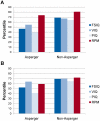The level and nature of autistic intelligence II: what about Asperger syndrome?
- PMID: 21991394
- PMCID: PMC3182210
- DOI: 10.1371/journal.pone.0025372
The level and nature of autistic intelligence II: what about Asperger syndrome?
Abstract
A distinctively uneven profile of intelligence is a feature of the autistic spectrum. Within the spectrum, Asperger individuals differ from autistics in their early speech development and in being less likely to be characterized by visuospatial peaks. While different specific strengths characterize different autistic spectrum subgroups, all such peaks of ability have been interpreted as deficits: isolated, aberrant, and irreconcilable with real human intelligence. This view has recently been challenged by findings of autistic strengths in performance on Raven's Progressive Matrices (RPM), an important marker of general and fluid intelligence. We investigated whether these findings extend to Asperger syndrome, an autistic spectrum subgroup characterized by verbal peaks of ability, and whether the cognitive mechanisms underlying autistic and Asperger RPM performance differ. Thirty-two Asperger adults displayed a significant advantage on RPM over Wechsler Full-Scale and Performance scores relative to their typical controls, while in 25 Asperger children an RPM advantage was found over Wechsler Performance scores only. As previously found with autistics, Asperger children and adults achieved RPM scores at a level reflecting their Wechsler peaks of ability. Therefore, strengths in RPM performance span the autistic spectrum and imply a common mechanism advantageously applied to different facets of cognition. Autistic spectrum intelligence is atypical, but also genuine, general, and underestimated.
Conflict of interest statement
Figures



References
-
- American Psychiatric Association. Diagnostic and statistical manual of mental disorders - Text revision. Washington, DC: American Psychiatric Association; 2000. 886
-
- Asperger H. “Autistic psychopathy” in childhood. In: Frith U, editor. Autism and Asperger syndrome. Cambridge: Cambridge University Press; 1944/1991. pp. 37–92.
-
- Kanner L. Autistic disturbances of affective contact. The Nervous Child. 1943;2:217–250.
-
- Rutter M. Behavioural and cognitive characteristics of a series of psychotic children. In: Wing L, editor. Early childhood autism: Clinical, educational and social aspects. Oxford: Pergamon Press; 1966. pp. 51–81.
-
- Happé F. Wechsler IQ profile and theory of mind in autism: a research note. Journal of Child Psychology and Psychiatry, and allied disciplines. 1994;35:1461–1471. - PubMed
Publication types
MeSH terms
Grants and funding
LinkOut - more resources
Full Text Sources
Research Materials

